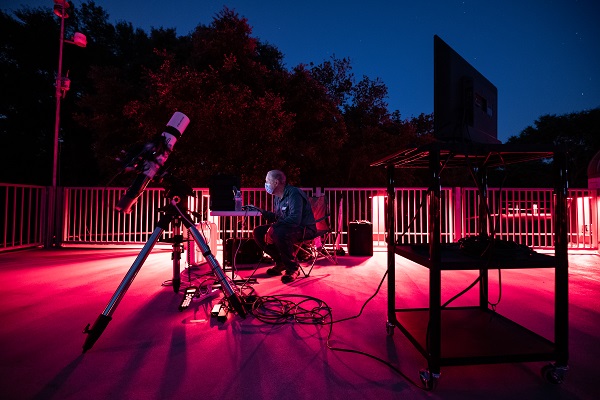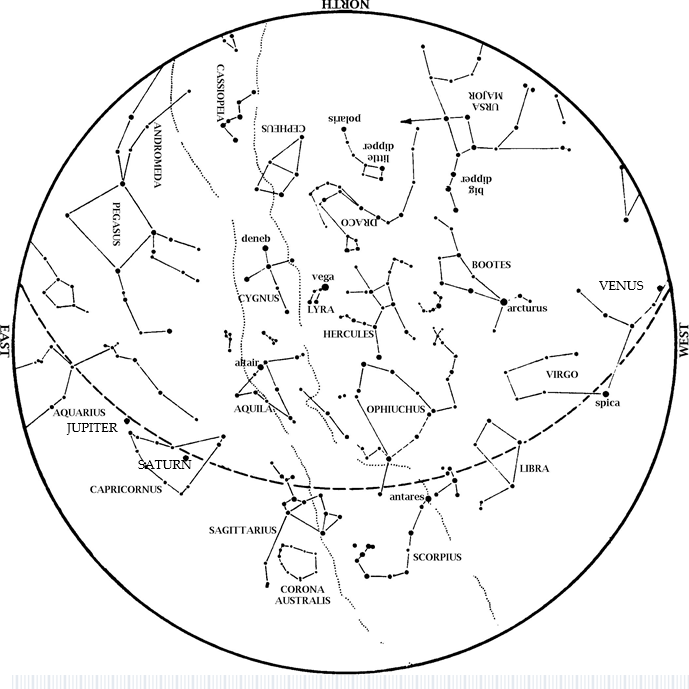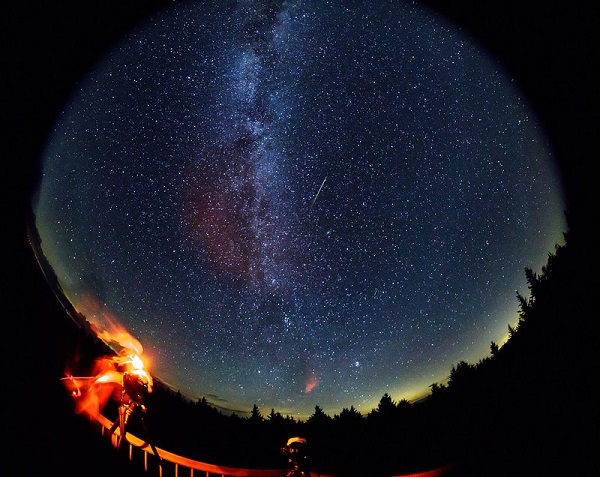Venus remains in the evening sky this month. Venus outshines everything except the Sun and the Moon, so it is unmistakable low in the west at dusk.
Jupiter and Saturn are up all night long this month. Saturn is at opposition on August 2, while Jupiter is at opposition on August 19. A planet comes to opposition when Earth passes between it and the Sun. Any planet at opposition rises at sunset and sets at sunrise. Look for Jupiter and Saturn rising in the east southeast as night falls and setting in the west southwest as day begins to break. Jupiter rises about an hour after Saturn and appears much brighter.
Mars becomes lost in the Sun’s glare this month and is thus no longer visible.
Taken at The George Observatory by HMNS Photographer Mike Rathke.
The Big Dipper is above and to the left of the North Star, with its handle pointing up. From that handle, you can ‘arc to Arcturus’. Arcturus is the brightest star we see on August evenings.
The Summer Triangle is high in the east at dusk. This consists of Deneb, Vega, and Altair, the brightest stars in Cygnus, Lyra, and Aquila respectively. Scorpius, the Scorpion, is in the south, with the ‘teapot’ of Sagittarius to his left. From the Big Dipper’s handle, ‘arc to Arcturus’ and ‘speed on to Spica’ in the southwest. The ‘teapot’ of Sagittarius to the left of Scorpius, with Saturn to the upper left of the ‘teapot’. When you face between these two constellations, you face the direction of the galactic center, which all stars in the Milky Way orbit. The Great Square of Pegasus rises in the east, heralding the coming autumn.
If you are far enough from bright city lights, you might look for the Milky Way band. This band is brightest near the galactic center and extends from there right through the Summer Triangle. In fact, every star we ever see in the sky with the naked eye is in our Milky Way. Indeed, our galaxy is so big that only stars relatively close to us appear as distinct stars; the rest of our galaxy blurs out and appears as the Milky Way band across our sky. For example, Deneb is about 1600 light years away, which is quite far. The entire Milky Way, however, is 100,000 light years across, making Deneb one of our relative ‘neighbors’. Thus, we see our Milky Way as a blur in the background with stars like Deneb (and Vega, Altair, Arcturus, etc.) in the foreground.
This star map shows the Houston sky at 10 pm CDT on August 1, 9 pm CDT on August 15, and dusk on August 31. To use the map, put the direction you are facing at the bottom. The Summer Triangle is high overhead. This consists of the brightest stars in Cygnus, Lyra, and Aquila. Scorpius, the Scorpion, is in the south, with the ‘teapot’ of Sagittarius to his left. From the Big Dipper’s handle, ‘arc to Arcturus’ and ‘speed on to Spica’ in the southwest. Jupiter and Saturn are close together in the southeast at dusk and up all night long this month. The Great Square of Pegasus rises in the east, heralding the coming autumn.
Moon Phases in August 2021:
New August 8, 8:50 a.m.
1st Quarter August 15, 10:20 a.m.
Full August 22, 7:02 a.m.
Last Quarter August 30, 2:13 a.m.
The Perseid meteor shower peaks every year in mid-August as Earth passes through debris left by Comet Swift-Tuttle. This year, the peak is August 11-13. Since it’s Earth running into the meteors and not the other way around, the leading edge of the Earth faces into the meteor stream. Therefore, we see more and more meteors as we approach dawn. The meteors can vary in brightness; getting away from city lights will help you see the dimmer ones as well as the brighter ones. Meteors can appear anywhere in the sky, so you’ll want to lie flat on your back to see as much of the sky at once as possible. Each meteor, once it appears, will seem to radiate from the constellation Perseus (hence the name of the shower). Under ideal conditions, you should average seeing about one meteor per minute. Keep in mind that a minute can feel like a long time if you’re waiting for something to happen!
In this 30 second exposure taken with a circular fish-eye lens, a meteor streaks across the sky during the annual Perseid meteor shower as a photographer wipes moisture from the camera lenses Friday, August 12, 2016 in Spruce Knob, West Virginia. Photo Credit: (NASA/Bill Ingalls)
Our George Observatory will be open Thursday night, August 12, until 2 am Friday morning, August 13, for viewing the Perseids. We are still limiting attendance due to COVID; purchase your tickets online in advance. Be sure to arrive by 9:30 pm to get into the park.
Our George Observatory is now open every Saturday night for observing! Purchase tickets in advance on our website.
Clear Skies!
Look back at our July 2021 Sky Happenings.









